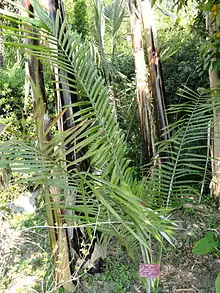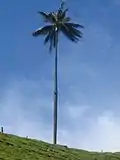Ceroxylon
Ceroxylon is a genus of flowering plant in the family Arecaceae, native to the Andes in Venezuela, Colombia, Ecuador, Peru, and Bolivia, known as Andean wax palms.[1][2][3]
| Andean wax palms | |
|---|---|
 | |
| Ceroxylon | |
| Scientific classification | |
| Kingdom: | Plantae |
| Clade: | Tracheophytes |
| Clade: | Angiosperms |
| Clade: | Monocots |
| Clade: | Commelinids |
| Order: | Arecales |
| Family: | Arecaceae |
| Subfamily: | Ceroxyloideae |
| Tribe: | Ceroxyleae |
| Genus: | Ceroxylon Bonpl. ex DC. |
| Synonyms[1] | |
| |
The species are almost exclusively montane and include the tallest palm (and thus tallest monocotyledon), C. quindiuense, which reaches 61 m (200 ft) in height, and species growing at the highest altitude of the palm family (Arecaceae), at more than 3,000 m (10,000 ft) in elevation.
The genus name is derived from Latin cēra ("wax") and Ancient Greek ξύλον (xúlon, "wood").
Description
Ceroxylon palms develop single, smooth, wax-covered, often whitish cylindrical trunks encircled by ringed leafbase scars. Ceroxylon species are dioecious (the individual plant produces flowers of only one sex). Leaves are pinnate. Inflorescences emerge from among, and often project conspicuously beyond, the leaves. Round fruits, up to one inch in diameter, are red or orange at maturity. Many Ceroxylon species are endangered by habitat destruction.
Two species of Andean wax palms, C. quindiuense and C. alpinum, provide nesting sites and food for a species of Colombian parrot now in danger of extinction, Ognorhynchus icterotis.
Cultivation
Several Ceroxylon species, including C. quindiuense, C. alpinum, C. vogelianum, C. ventricosum, and C. parvifrons, are cultivated as ornamental trees outside their native range in cool, humid, mild climates with minimal frosts, such as parts of Australia, coastal California, Hawai'i, New Zealand, South Africa, and coastal Western Europe. The Jose Celestino Mutis Botanical Garden in Bogotá, Colombia, contains an extensive planting of Ceroxylon palms. Other public gardens where cultivated Ceroxylon spp. can be viewed include the San Francisco Botanical Garden in Golden Gate Park, San Francisco, California, the Huntington Botanical Gardens, in Pasadena (near Los Angeles), California, and the Oakland Palmetum at the Lakeside Garden Center in Oakland, California.
Species
The genus contains the following species:[3]
| Image | Scientific name | Distribution |
|---|---|---|
_(14329134127).jpg.webp) | Ceroxylon alpinum Bonpl. ex DC. | Colombia, Venezuela |
| Ceroxylon amazonicum Galeano | Ecuador | |
_-_Flickr_-_Alejandro_Bayer_(1).jpg.webp) | Ceroxylon ceriferum (H.Karst.) Pittier | Colombia, Venezuela |
.jpg.webp) | Ceroxylon echinulatum Galeano | Ecuador, Peru |
 | Ceroxylon parvifrons (Engel) H.Wendl. | Colombia, Venezuela, Ecuador, Peru, Bolivia |
| Ceroxylon parvum Galeano - | Ecuador | |
| Ceroxylon peruvianum Galeano, Sanín & K.Mejia | Peru | |
| Ceroxylon pityrophyllum (Mart.) Mart. ex H.Wendl. | Peru, Bolivia | |
 | Ceroxylon quindiuense (H.Karst.) H.Wendl. | Colombia |
| Ceroxylon sasaimae Galeano | Antioquia, Cundinamarca | |
.jpg.webp) | Ceroxylon ventricosum Burret | Colombia, Ecuador |
.jpg.webp) | Ceroxylon vogelianum (Engel) H.Wendl. | Colombia, Venezuela, Ecuador, Peru |
References
- "World Checklist of Selected Plant Families: Royal Botanic Gardens, Kew". apps.kew.org. Retrieved 2016-01-19.
- Govaerts, R. & Dransfield, J. (2005). World Checklist of Palms: 1-223. The Board of Trustees of the Royal Botanic Gardens, Kew.
- Sanin, Maria Jose; Galeano, Gloria (2011). "A revision of the Andean wax palms, Ceroxylon (Arecaceae)" (PDF). Phytotaxa. 34 (34): 1–64. doi:10.11646/phytotaxa.34.1.1. Retrieved 18 January 2016.